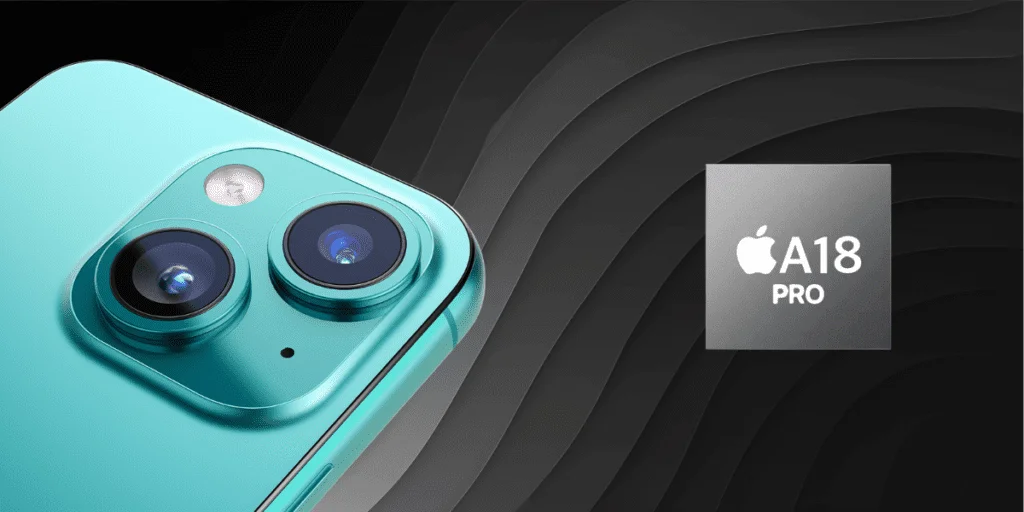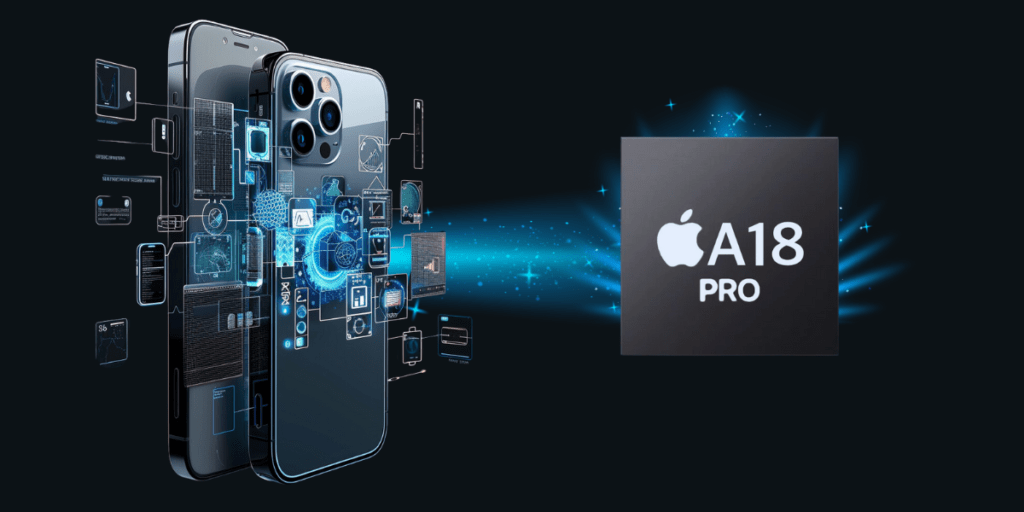Competitive world of smartphone technology, every new chip release promises to push the boundaries of what our devices can achieve. Recently, a significant leak concerning Apple’s upcoming A18 Pro chip has set the tech community abuzz.
This new processor is rumoured to feature in the iPhone 16 Pro models and has reportedly demonstrated exceptional single-core performance in preliminary benchmarks.
If these leaks hold true, the A18 Pro could not only eclipse the performance of its predecessor, the A17 Pro. Still, it might also surpass the capabilities of high-end chips like Qualcomm’s Snapdragon 8 Gen 4 and even Apple’s own M3 chip used in the 16-inch MacBook Pro. T
his introduction explores the implications of these benchmark scores and what they could mean for the future of Apple’s smartphone lineup.
Apple A18 Pro Chip
The latest scoop in the tech world comes from a series of leaked benchmark results for Apple’s yet-to-be-released A18 Pro chip. According to a post by user Nguyen Phi Hung on X the A18 Pro is setting new standards in processing power.
The benchmark scores were shared on the social media platform X, showcasing the single-core and multi-core Performance of the A18 Pro chip.
Single-Core Test A18 Pro chip achieved a score of 3,500 points.
Multi-Core Test, In contrast, the multi-core score reached 8,200 points.
These scores indicate a significant improvement over the previous generation. For reference, the iPhone 15 Pro Max, powered by the A17 Pro chip, scored 2,898 points in the single-core Test and 7,201 points in the multi-core Test.

This represents a 20.77% improvement in single-core Performance from the A17 Pro to the A18 Pro.
The single-core Performance is particularly noteworthy as it provides an indicator of the chip’s efficiency and speed in handling linear tasks, which are crucial for the overall speed and responsiveness of the device.
These benchmark results suggest that Apple is making substantial strides in enhancing the processing capabilities of its devices, potentially offering users faster and more efficient Performance than ever before.
This leap could have wide-ranging implications for both everyday use and specialized applications, reaffirming Apple’s commitment to innovation in the highly competitive tech landscape.
Comparison with Competitors
The leaked benchmarks for Apple’s A18 Pro chip not only highlight its improvements over previous iterations but also position it in a competitive landscape with major chip manufacturers like Qualcomm. Here’s how the A18 Pro stacks up against its key competitors:
Qualcomm’s Snapdragon 8 Gen 4
Single-Core Performance: the A18 Pro outshines with a score of 3,500 points, compared to Qualcomm’s Snapdragon 8 Gen 4, which scored 2,845 points in the same Test.
This marks a notable lead for Apple in single-core efficiency, which is crucial for tasks that depend on raw processing power from a single core.
Multi-Core Performance In multi-core Performance, the Snapdragon 8 Gen 4 takes the lead with a score of 10,628 points, significantly higher than the A18 Pro’s 8,200 points. Multi-core Performance is key for multitasking and handling complex tasks that can be distributed across multiple cores.
Comparison with Apple’s Own M3 Chip
The A18 Pro’s single-core score also surpasses that of Apple’s powerful M3 chip used in the 16-inch MacBook Pro, which scores 3,230 points. This is an impressive feat, considering the M3 chip powers a high-end laptop. It is designed for more intensive computing tasks.
These comparisons indicate Apple’s strategic advancements in chip technology, focusing not just on improving power but also on efficiency and task handling.
The A18 Pro chip strikes a balance between single-core Performance and power efficiency, setting a new standard for mobile processors.
With these benchmark scores, Apple could reshape expectations for smartphone performance, potentially affecting consumer preferences and the competitive dynamics between flagship smartphones and even portable computers.
This competitive analysis underscores the significance of Apple’s advancements in its chip technology, suggesting a robust challenge to competitors in both the smartphone and broader portable computing markets.
Implications for Future Devices
The A18 Pro chip’s impressive benchmark scores suggest several potential implications for future Apple devices, particularly the iPhone 16 Pro series and potentially other Apple hardware. Here’s what these developments could mean for future Apple products.
With its superior single-core performance, the A18 Pro chip is likely to deliver faster operational speeds for applications that rely heavily on single-thread performance, enhancing the overall user experience with quicker app launches, smoother interactions, and more responsive gaming experiences.
Improved efficiency in the A18 Pro could also mean better battery management, allowing future devices to run longer on a single charge despite higher processing power.

The increased power of the A18 Pro chip might enable more advanced augmented reality (AR) and artificial intelligence applications, which require substantial computational power to process data in real time.
Enhanced processing capabilities could improve image and video processing algorithms, leading to better camera performance, including faster autofocus, improved low-light performance, and more complex video editing capabilities directly on the device.
The leap in performance metrics could give Apple a significant competitive advantage in the high-end smartphone market, appealing to both power users and those whose primary device usage includes gaming, professional photography, and video production.
The A18 Pro’s architecture might influence future designs in other Apple products, such as iPads and possibly even lower-end MacBook models, especially as Apple continues to integrate its ecosystem more tightly with shared technologies and functionalities.
As Apple pushes the boundaries of what its chips can handle, competitors are likely to accelerate their own innovations, leading to rapid advancements in mobile technology capabilities across the industry.
Higher performance benchmarks will increase consumer expectations for what mobile devices should be able to do, pushing the entire industry towards more powerful and efficient designs.
The implications of the A18 Pro’s leaked benchmarks suggest a significant shift not just for future iterations of the iPhone but potentially across the entire spectrum of mobile and portable computing devices.
These advancements could redefine user experiences, extending well beyond mere improvements in speed to influence how we interact with our devices on a daily basis.
Market Analysis
The introduction of Apple’s A18 Pro chip and its demonstrated performance in leaked benchmarks presents noteworthy implications for the mobile processor market. Here’s a deeper look into how these developments might shape the competitive landscape and consumer trends:
Apple’s A18 Pro surpasses Qualcomm’s latest in single-core performance, which may prompt Qualcomm and other competitors like Samsung and MediaTek to accelerate their own advancements in chip technology.
This could lead to a more rapid evolution of mobile processor capabilities across the board.
Android device manufacturers relying on Qualcomm chips might feel compelled to optimize software or seek alternative solutions to match Apple’s performance, influencing overall market strategies and product offerings.
As consumers become more aware of the implications of processing power on their user experience, demand for high-performance devices may increase, influencing purchasing decisions.
This is particularly relevant in segments like gaming, professional photography, and business applications where processing speed and efficiency are critical.
Superior performance specs might persuade some users to switch to or stick with Apple, reinforcing brand loyalty among current users and potentially attracting customers from Android, especially those dissatisfied with their current devices’ performance.
Apple’s continued focus on integrating hardware with software could lead to more optimized devices that leverage the A18 Pro’s capabilities, potentially setting new benchmarks for what smartphones can achieve in terms of battery life, AI, and AR applications.
As chip performance increases, so does the potential for more sophisticated apps and services, driving a cycle of innovation that benefits developers and consumers alike.
With higher performance, Apple can justify premium pricing for its Pro models, which may affect the entire pricing structure within the smartphone market, pushing up prices for high-end models.
The competition to lead in chip performance will likely result in increased investments in research and development across the industry, impacting economic strategies at large tech companies.
Enhanced capabilities often require advanced manufacturing techniques and materials, which can have downstream effects on supply chains and production timelines. Companies will need to navigate these complexities to meet demand without compromising on quality.
Potential Challenges
While the leaked benchmarks of Apple’s A18 Pro chip suggest considerable advancements in performance, there are several challenges and limitations that could impact the actual deployment and reception of this technology.
The initial data comes from leaks rather than official sources, raising questions about the authenticity and reliability of the reported benchmark scores. Until Apple confirms the specifications and performance metrics, scepticism may remain.
Overhyped expectations based on preliminary leaks can lead to disappointment if the final product does not match the anticipated performance, affecting consumer trust and product reception.
High-performance chips, especially those improving significantly in power, can face issues with heat dissipation. Managing this without compromising device design or additional cooling requirements poses a substantial challenge.
While efficiency improvements are a goal, the higher power draw of more capable processors could negatively impact battery life unless offset by advancements in battery technology or power management features.
The smartphone market, particularly at the high end, is becoming increasingly saturated. Consumers may not feel the need to upgrade to the latest model if their current devices meet their needs adequately, potentially limiting the market impact of new innovations.
Advanced technology typically comes at a higher cost. The pricing strategy for devices equipped with the A18 Pro chip will be crucial in determining its market success, especially in economically diverse global markets.

The production of advanced chips requires sophisticated materials and processes that might be constrained by global supply chain issues, such as those triggered by geopolitical tensions or pandemics.
While pushing the envelope on performance, Apple must balance innovation with practical engineering solutions that can be produced at scale without diminishing returns.
The full benefits of the A18 Pro can only be realized if the software, particularly iOS, is optimized to take full advantage of the new hardware capabilities. This requires not only updates at the system level but also encourages third-party developers to update their applications.
As new technologies render older devices obsolete faster, issues related to electronic waste and the recycling of old tech become more pressing.
Any new technology, particularly one that involves communication capabilities, must comply with international regulations, which can vary widely and impact the rollout of new devices.
These challenges highlight the complexities involved in introducing a technologically advanced product to the market. They necessitate a well-rounded approach that addresses technical, economic, and regulatory aspects to ensure successful adoption and utilization.
Final Thoughts
The leaked benchmarks of Apple’s A18 Pro chip paint a promising picture of future advancements in smartphone technology, signalling potentially groundbreaking improvements in processing power and efficiency.
These developments could redefine user expectations and set new standards for what mobile devices are capable of achieving.
It’s important to approach these leaks with cautious optimism. The real-world implications of such technological leaps are contingent on numerous factors, from the veracity of the initial data to the practical execution of final products.
Apple’s ability to manage these expectations—balancing innovation with reliability and cost—will be crucial.
The introduction of the A18 Pro chip is likely to stimulate further innovation across the tech industry, pushing competitors to accelerate their own advancements. This could lead to a virtuous cycle of improvement in processing power, efficiency, and even battery life that benefits all users.
While the A18 Pro chip promises significant technological advancements, its success will depend on a complex interplay of market dynamics, consumer reception, and Apple’s strategic decisions.
The anticipation surrounding these developments not only highlights the technological prowess of Apple’s upcoming devices but also underscores the ever-increasing role of sophisticated chip technology in driving the next generation of digital innovation.
As we look forward to the official release and real-world performance of the A18 Pro, the tech community remains abuzz with speculation and excitement, underscoring the profound impact that such innovations have on our interactions with technology in daily life.


